
Maserati Grecale Review

Introduction
The Maserati name might be big, but the Italian brand’s range is surprisingly small. For years, now, the core line-up has comprised the Ghibli saloon and the Quattroporte limousine, plus the Levante SUV.
Admittedly, the MC20supercar has now arrived and the Gran Turismo sports car soldiered on for ages, but they are small beer compared with the rest of the range. Now, though, there’s a new volume proposition called the Grecale, a mid-size SUV designed to sit beneath the Levante and rival the Porsche Macan.
With an eye on the future, Maserati has given the Grecale some mild-hybrid powertrains, but there’s also a high-performance Trofeo model for the Maserati die-hards. But to achieve the volume Maserati might like, the Grecale can’t just be fast.
It also has to be premium, powerful and dynamic enough to beat the likes of the BMW X4 and Range Rover Velar.
That’s a difficult task, and Maserati has its work cut out if it wants the Grecale to be a success.
Select's rating score* - 3.4 / 5
At a Glance
The Grecale has a slightly cuter face than most of its stablemates, but it’s still unmistakably a Maserati product. The gaping grille, three air vents on the flanks and the trident logo on the haunches all make sure you’re left in no doubt of the Grecale’s provenance.
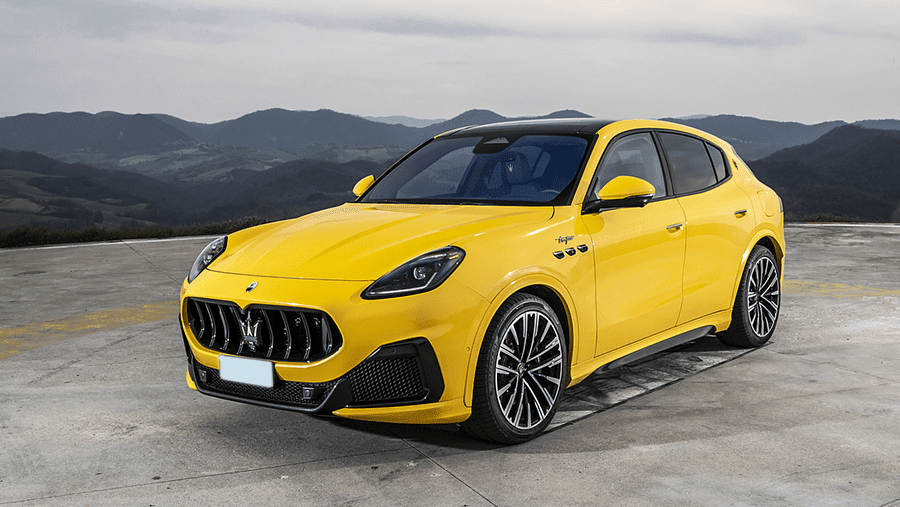
But the new SUV has a slightly softer side, with its doe-eyed headlights and rounded wheel arches that make it look a little less aggressive.
Inside, the cabin is a big departure for Maserati, showcasing a new, more high-tech brand.
The steering wheel is festooned with buttons, but the dashboard is almost entirely clean, with two central touchscreens taking over most of the vehicle functions, while a digital instrument display lurks behind the wheel.
That’s merged with stylish curves and some brightwork on around the air vents, which make it look classy and upmarket.
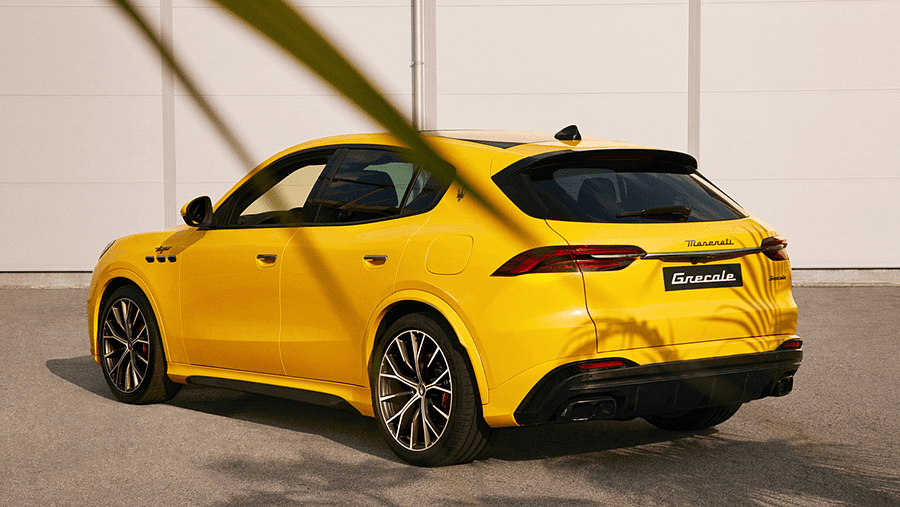
Unfortunately, while build quality isn’t bad for the most part, there are issues with the materials in the cabin, some of which feel plasticky and loose. The Grecale does have plenty of space in the back and in the boot, though, which means it’s a very practical thing.
It also comes with some very competent engines, including two 2.0-litre petrol engines with mild-hybrid technology and at least 300hp, while there’s also a Nettuno V6 petrol engine that’s fitted to the range-topping Trofeo.
Although the Grecale drives well and proves surprisingly refined, it isn’t quite as engaging or as agile as a Porsche Macan or a BMW X3.
Key Features
As with any Maserati, the engine is the Grecale’s heart and soul.
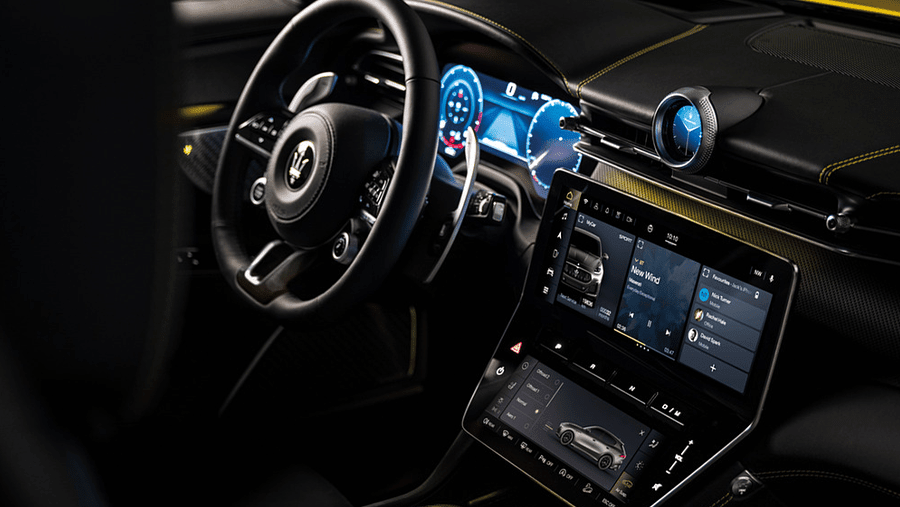
The basic 2.0-litre engines are refined and make a surprisingly pleasant burble when pushed, and they’re also relatively fuel efficient, but the Nettuno V6 in the Trofeo is a snarling, fire-breathing highlight of the range.
With a massive 530hp at its disposal, it might have a thirst for unleaded, but it’s also intoxicatingly powerful. As the saying goes, there’s no replacement for displacement.
Aside from that, the most important feature of the new Grecale is the new twin-touchscreen infotainment system and the digital instrument display. The new system is much better than anything Maserati has come up with in the past, offering crisp responses and even crisper graphics, putting it up there with other premium brands’ offerings.
There’s also a little Easter egg in the digital clock display, which works in tandem with the touchscreen to be used as a G-meter or even a compass, as well as a traditional clock face.
Performance & Drive
The Grecale comes with a choice of engines, ranging from an ‘entry-level’ 2.0-litre petrol to a fire-breathing turbocharged V6 petrol. There are no diesel options, and although Maserati likes to call its 2.0-litre engines ‘hybrids’ they are in fact mild-hybrids, meaning they basically have a glorified stop-start system.
An electric version is on the way however, although it’s not clear when that will finally arrive.
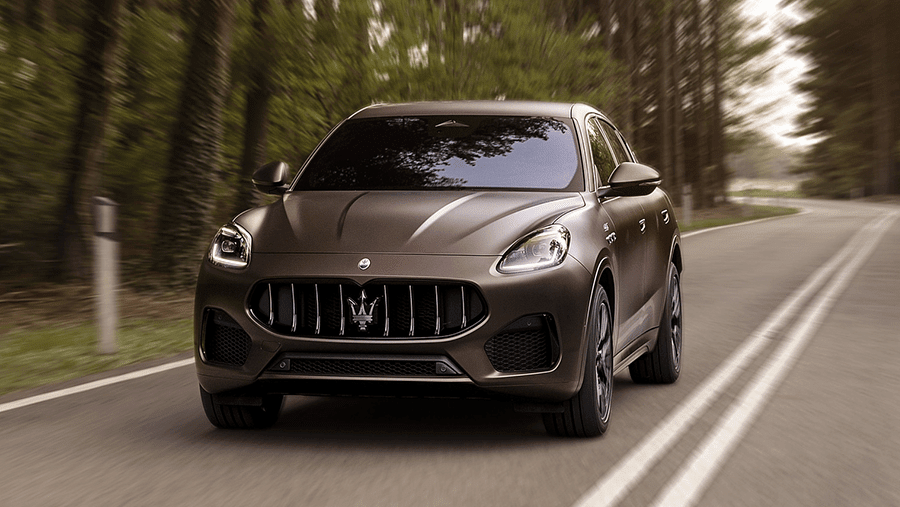
Because each trim level comes with its own engine, a la Porsche, the basic option is the 2.0-litre GT model, which has a healthy 300hp and gets from 0-62mph in 5.6 seconds, which is more than fast enough for most.
It makes a pleasant noise as it goes, too, and it’s incredibly smooth, which makes the Grecale GT very refined on a long motorway drive.
Above the GT is the Modena, which uses the same basic engine to produce an extra 30hp, offering a slightly improved 0-62mph time and the same 149mph top speed. The Modena does, however, come with revised chassis settings more akin to those found on the top-of-the-range Trofeo.
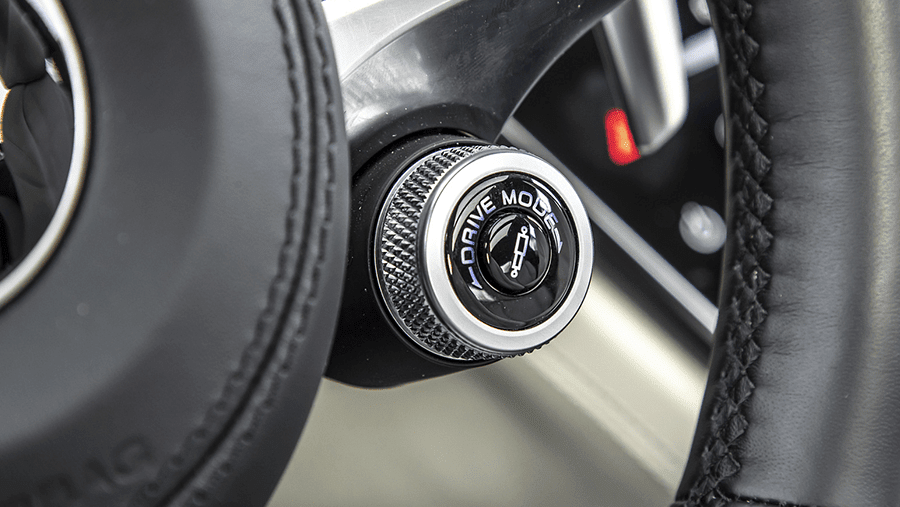
Speaking of which, that car is the jewel in the Grecale crown, harbouring a 3.0-litre V6 petrol engine with 530hp and its own bespoke chassis set-up. That means it’s a little less comfortable than the GT model, but it’s a lot faster both in corners and in a straight line. The sprint to 62mph takes just 3.8 seconds and the car tops out at 177mph.
Every version of the Grecale is reasonably enjoyable to drive, with a rear-biased all-wheel-drive system that makes it feel balanced in corners, while the response from the front wheels is sharp and body roll is relatively controlled.
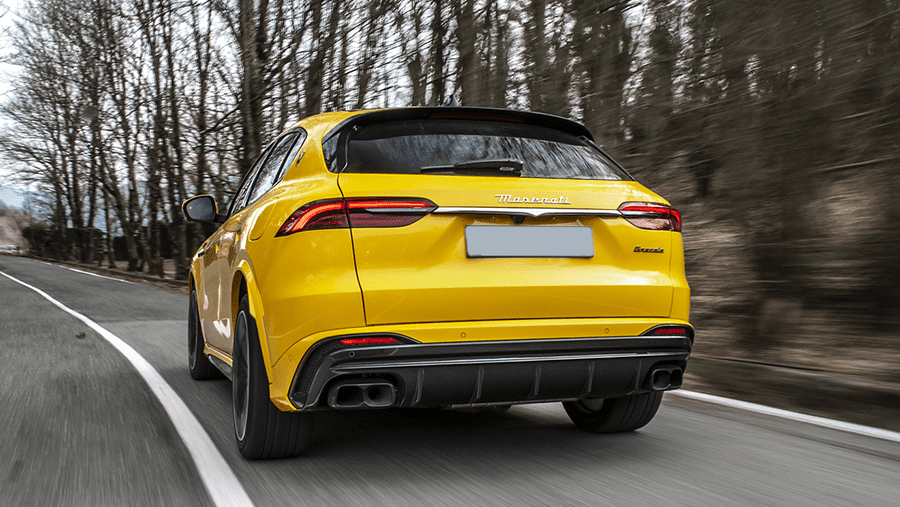
However, the steering feels numb and the whole thing feels less precise than a Porsche Macan or BMW X3, but they’re the class leaders and the Maserati is easily a match for a Lexus NX or a Volvo XC60 – especially in its sharper Trofeo form.
However, the Trofeo feels a little unsettled over rough surfaces, even in Comfort mode, and it generally doesn’t have the stability or smoothness of a Macan or an X3.
The GT model is a little softer and therefore more secure on the road, but while it’s fine on motorways, there’s still something bubbly about the rear end at lower speeds, and that doesn’t inspire much confidence or comfort.
Running Costs & Emissions
Although the Grecale might wear the Maserati badge, it isn’t all blood and thunder. Well, the Trofeo is a bit, but the two 2.0-litre engines offer more than just performance.
With mild-hybrid technology under the bonnet, the two smaller engines achieve just over 30mpg, which is slightly more than you’ll get from the equivalent Porsche Macan. The Trofeo, however, is a little thirstier.

Until the electric model arrives, the 2.0-litre options are the ones to go for, but they won’t suit everyone’s needs. With no plug-in hybrid option available, company car drivers might prefer to pick a BMW X3 30e, which will be considerably cheaper to tax, or even the forthcoming battery-powered Genesis GV70 Electrified, which is set to be even cheaper.
Interior & Technology
Maserati is pitching the Grecale’s interior as a key selling point, and so it should be. At a glance, the cabin looks great, with its clean design, two massive touchscreens and the digital instrument display. The central clock draws the eye, too, as does the steering wheel that’s festooned with buttons and dials.
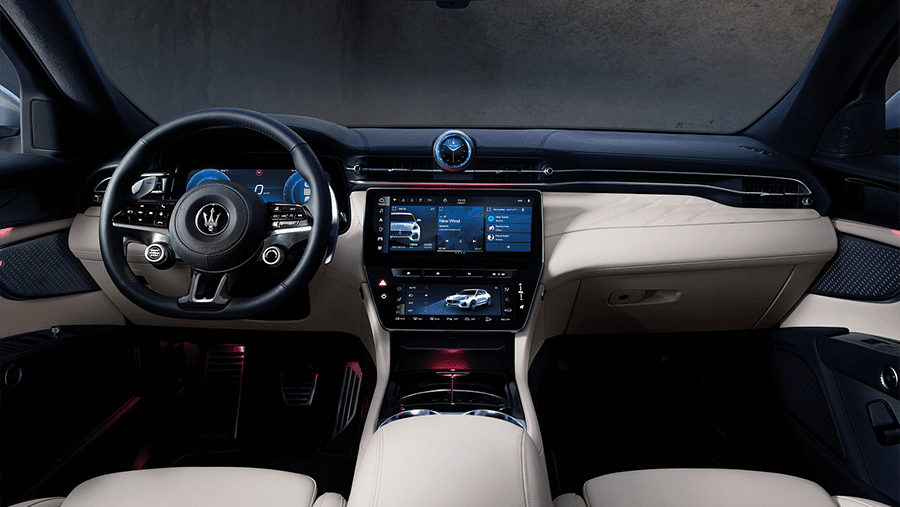
But while the cabin looks great, it doesn’t always feel that way. Some of the metal-effect plastic trim around the dashboard and the doors feels quite cheap, and the buttons on the steering wheel are rickety and uninspiring.
But they are the only real gripes, and the Grecale’s interior is very solid, with everything bolted together quite well. It’s a disappointment compared with a Porsche or a BMW, but it’s only a few aspects that really let the side down.
Build quality aside, however, the Grecale’s cabin has plenty going for it. There’s plenty of space in the back, with more than enough legroom, although very tall passengers will find the roofline a little bit tight. But the boot is big, with 535 litres of capacity in the boot for 2.0-litre models, while the Trofeo has 570 litres of luggage space.

And there’s fresh technology, in the shape of those two touchscreens, the clock and the digital instrument display. The clock is the biggest surprise, with its choice of functions, while the instrument cluster is arguably the most impressive. Clean, configurable and easy to use, it’s a massive step forward for Maserati, although we’ll always miss those lovely blue analogue dials.
Instead, you get the two touchscreens to play with, and there’s plenty to play with. Maserati has done away with most of the switchgear in a bid to tidy up the interior, and that means functions have been moved to the touchscreen.
Ordinarily, that might be an issue, but the Grecale’s screens are none too bad. Crisp and ergonomic, they work relatively well, even if they get caught out now and then.
They’re far better than anything Maserati has come up with before, though.
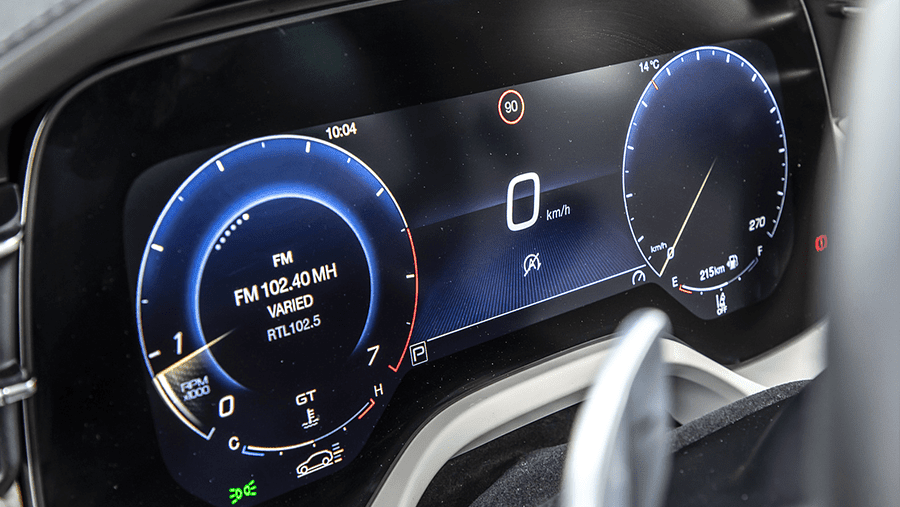
Practicality & Boot Space
The Grecale may be Maserati’s smallest SUV, but it isn’t that small. It’s based on the same platform as one of its rivals, the Alfa Romeo Stelvio, but the car has been stretched out a bit and even the most cramped versions provide 535 litres of load-carrying capacity with all five seats in use.
That’s good going for a car of this size, and it’s plenty for most customers’ needs, but the V6-powered Trofeo models do without the space-sapping mild-hybrid system, and that means there’s even more space in the back, making the Trofeo the surprise choice for those seeking practicality.

Of course, boot space is not the be all and end all, but the Grecale also scores well when it comes to passenger space. Those in the front will have plenty of room, and those in the back will enjoy ample clearance between their knees and the seat in front.
Headroom is a little less plentiful, but only the tallest passengers will find the top of their bonce scraping the roof lining.
Safety
Euro NCAP has not yet tested the Grecale, and given the Ghibli is the only model to have been tested so far, it looks unlikely to do so. Nevertheless, the related Alfa Romeo Stelvio has been put through its paces, and it passed with flying colours.
On its way to a five-star safety rating, it achieved a hugely impressive 97% score for adult occupant protection, while also scoring highly for protection of child occupants.

What’s more, the Grecale is available with a wide range of safety systems, including adaptive cruise control that maintains a safe distance to the car in front, and driver drowsiness monitoring.
The car is also offered with lane-keeping assistance and blind-spot monitoring to help the driver remain in their lane and alert the driver to vehicles in the blind spots over the driver’s shoulders. Parking sensors and a reversing camera are also on offer.
Options
The Grecale range is fairly simple, with just three options to choose from. The basic model is the 2.0-litre GT, and that comes with 19-inch alloy wheels, satellite navigation and leather upholstery as standard. The car also features the digital instrument display, 10-way electrically adjustable seats, and climate control.
Moving up to the Modena model gets larger wheels, wood trim and contrast stitching as standard, as well as premium leather upholstery, but apart from the sportier rear axle and more powerful engine, changes aren’t that numerous.

Of course, the Trofeo is a little more upmarket, with its performance-orientated upgrades, black exterior trim and a slightly sportier feel to the cabin, as well as 21-inch alloy wheels.
Options are not numerous, but the Grecale is available with a choice of colours, including a stunning shade of metallic blue and a bright yellow. There’s also a range of interior colours to choose from and a selection of dashboard trims, not to mention a small bunch of option packs.
There are two driver assistance packs with a range of safety systems and a Travel Pack with cargo rails in the boot floor. On the single options front, there’s a heated steering wheel, front seat ventilation and heated rear seats, as well as roof rails and a 360-degree manoeuvring camera.
Rival Cars
In an attempt to grow its market, Maserati is taking on a very large sector filled with very competent cars. But a small slice of a large pie is better than nothing, and the Italian company will hope the Grecale can take customers away from cars that have already made a name for themselves.
Chief among these is the Porsche Macan, which is getting long in the tooth but remains the master of its art. No SUV on the market drives this beautifully, is this well built or has such a brilliant selection of engines. In every form, it’s a masterpiece.

But even the Macan does not want for rivals. The BMW X3 and the closely related but more coupe-shaped X4 are both very exciting cars to drive, particularly in their more powerful guises, while the Mercedes-Benz GLC is a high-tech, comfortable and luxurious proposition. Then there’s the Audi Q5, which majors on quality and technology, and the Lexus NX, which does a similar thing with a little more flair.
Other competitors include the Volvo XC60, which is more style- and comfort-orientated, and the Jaguar F-Pace, which is much more of a sporty SUV, as befits the badge. Alternatively, you could also choose the Range Rover Velar or the Alfa Romeo Stelvio, which are arguably the best-looking cars in this class. And if you want something really left-field, there’s always the well-built and well-equipped Genesis GV70, which is a surprise contender in such illustrious company.

Verdict & Next Steps
The Grecale is not quite good enough to beat the Porsche Macan, which still reigns supreme even after all these years on the market. But while the Grecale is not as well built or as brilliant to drive, that doesn’t mean it lacks plus points. This is still a solid option in the market, with an exclusive badge, strong practicality and an even stronger engine range. If you don’t want to follow the herd with one of the usual German suspects, the Grecale will be well worth a look.
Where to next?
View our latest Maserati Grecale Leasing Deals - from just £803.00 per month inc VAT**
Looking for a great leasing deal? Check out our incredible range of Special Offers
New Hatchback? Read our latest Car Reviews and find the right model for you
Want to know more about leasing? Take a look at our comprehensive Leasing Guides
Interested in everything motoring? Why not catch up on all the latest Car Leasing News.
*Score based on Select’s unique meta score analysis, taking into account the UK’s top five leading independent car website reviews of the Maserati Grecale
**Correct as of 01/09/2022. Based on 9 months initial payment, 5,000 miles over a 48 month lease. Initial payment equivalent to 9 monthly payments or £7,227.00 Ts and Cs apply. Credit is subject to status.


















